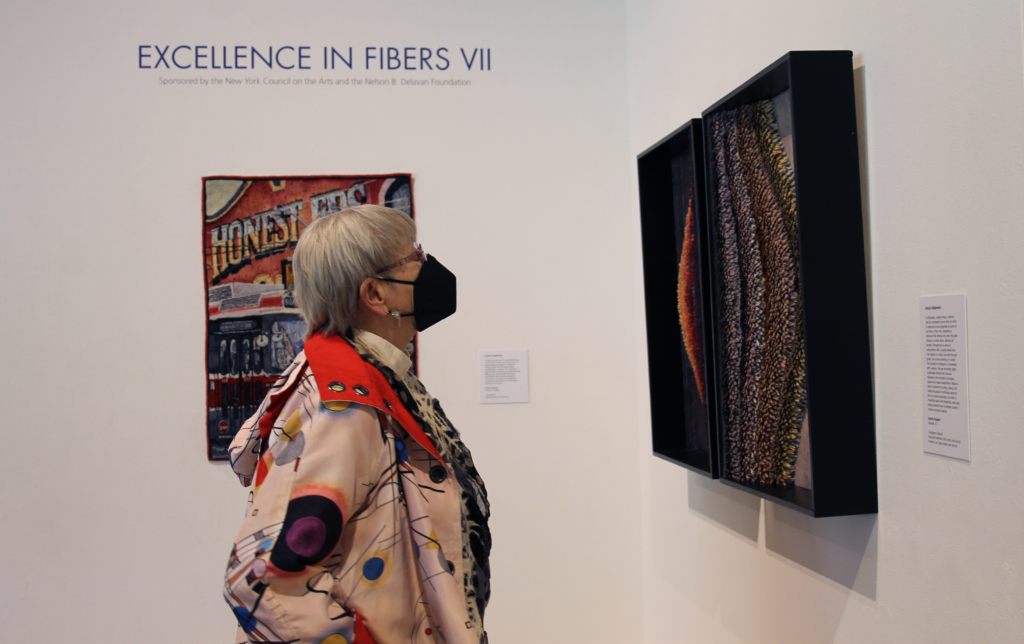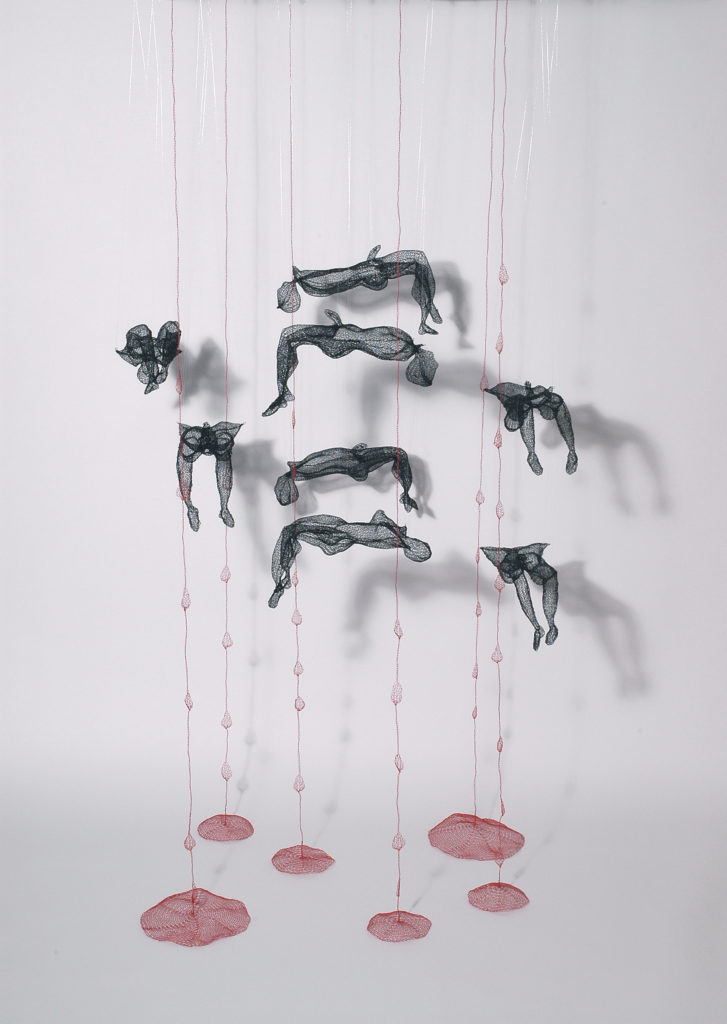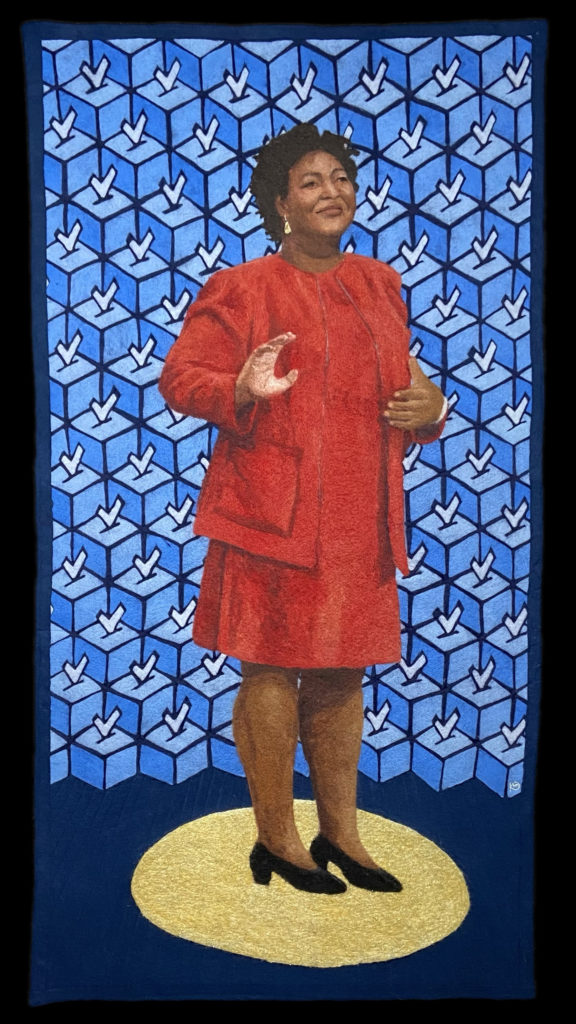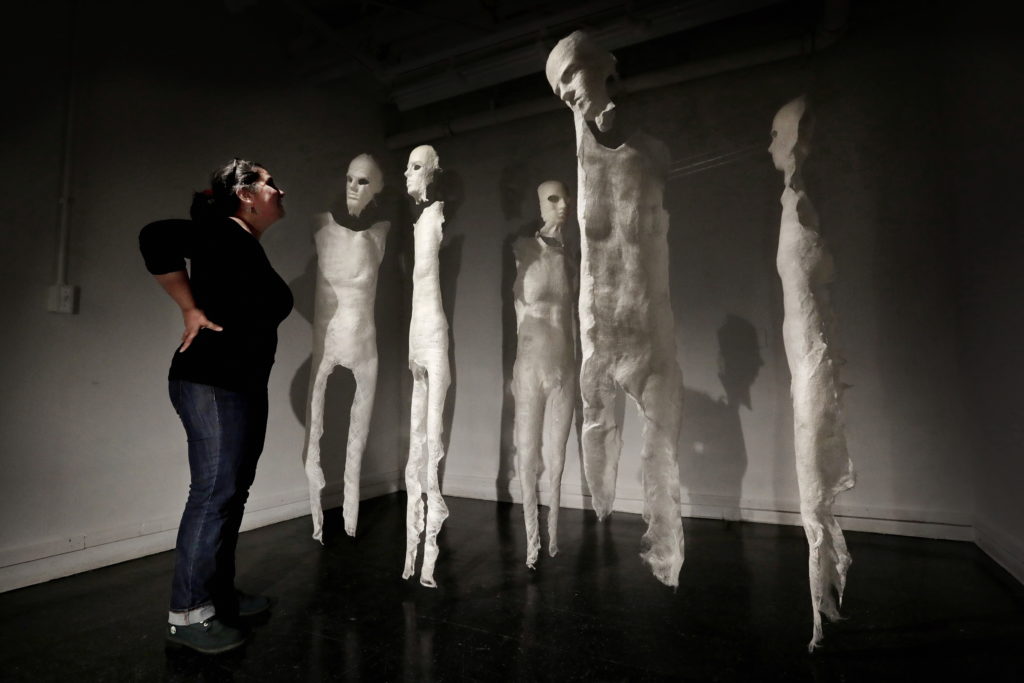Art takes on political undertones in “Excellence in Fibers VII”

“Truth to Power,” fiber artist Adrienne Sloane’s piece in the Schweinfurth Art Center’s latest exhibit, compels viewers to stop and examine it.
Hanging from the ceiling are several supine male and female figures, with blood-red crocheted wire forms falling down into a circle underneath. The figures move with the slight breeze as visitors pass it, adding to its impact. There’s no mistaking the strong anti-war message that Sloane’s work invokes – her goal in creating it.
The piece is one of several in the exhibit “Excellence in Fibers VII,” on display at the Schweinfurth through Aug. 14, 2022, that highlight political topics, including voting rights, the U.S. Supreme Court, and dictatorships. The exhibit was curated by Fiber Art Now, a national fiber art magazine, and includes international artists.
“Many of the pieces in ‘Excellence in Fibers’ have political undertones,” said Schweinfurth Program Director Davana Robedee. “The artists are reacting to their surroundings, to the world around them, most with nontraditional fiber materials.”
For some, the message is a result of intent, such as Sloane’s piece. For others, their work is a reaction to information they recently learned.

Political activist, too
The biography on Sloane’s website describes her as “a contemporary fiber artist with a political focus.” One could also say political activist. In addition to making art about political issues, she conducted several postcard campaigns in which she gave postcards with her artworks to anyone who would use it to lobby their Congress members.
“By visually addressing the frayed and unraveled places around me, I hope to promote thoughtful dialogue about critical questions as we navigate the difficult times we live in,” said Sloane, of Lexington, MA.
In fact, “Truth to Power” was created in response to feedback about an earlier piece she made, “Cost of War.” That artwork, which was displayed at Fiberart International in 2007, portrayed only men as casualties of war.
Artist Gray Caskey of Portland, OR, made her piece, “Dissenting,” as a memorial to Ruther Bader Ginsburg “as well as a recognition of my own loss of hope in her passing.” The work was completed around the same time that Ginsburg died, and it draws its title from the Supreme Court justice’s collars that she wore over her robes when she disagreed with the majority’s opinion.
“Upon knowing this is a tribute to Ruth Bader Ginsburg, I hope the viewer feels a sense of reverence,” Caskey said. “While they may not be able to feel the physical weight of the piece, I hope they are able to imagine and empathize with the load that fell on Ginsburg’s shoulders for so many years.”
She said that she doesn’t typically make political statements in her work, but that seems to be changing. “I now have additional pieces in progress that speak to our current political climate,” she said. “I’m not sure if this is a new direction for my work or just a reflection of these unprecedented times. This is just my current process of trying to make something beautiful despite everything falling apart around us.”

Art with social commentary
Recently acquired knowledge led Katherine McClelland, of West Springfield, MA, to create “Stacey Abrams,” a felted portrait of the Georgia politician, author, and voting rights activist. McClelland became aware of Abrams in 2018 when she lost her race for Georgia’s governorship.
“My goal for this piece was to honor Ms. Abrams and her work to ensure voting rights, McClelland said. “Beyond my admiration of Ms. Abrams, my motivation for this piece was influenced by the fact that we, as a country, have a long way to go to ensure all voices are heard. Until we have accurate representation, we will not see true equity in our communities.”
She said her work often challenges accepted norms, and art is her way to have an impact on the world. “Creating textile art with a social commentary feels appropriate and in line with a long tradition of women makers who used this discipline to have a voice in a world that would prefer their silence,” McClelland said.
Sometimes the political message sneaks out even when the artist doesn’t intend it. Paulina Fuenzalida-Guzman, a native of Chile who now lives in Acushnet, MA, created “Glint,” featuring five ghostly figures that hang from the ceiling. Two sets looks at each other with unemotional faces, while the last stares off in a different direction.
Fuenzalida-Guzman intended the piece to show glances and ways of seeing the world. However, her experience growing up under the Pinochet dictatorship pervades her art, even subconsciously. “The dictatorship committed many injustices and human rights violations, and the violence inflicted on my compatriots for dissenting disturbed me,” she said.
“Glint” connects both. “Some of the figures connect their gazes, producing a glint,” Fuenzalida-Guzman said. “That attitude of closeness speaks of empathy, something that we lost during the Pinochet dictatorship and caused us a lot of sorrow. On the other hand, another figure looking in the opposite direction symbolizes a different way of thinking that we must also respect. I do not want intolerance to be repeated in my country or anywhere else.”

